As Ukrainians liberated Staromaiorske, soldiers spent a month fighting alongside bodies of their enemies
EL PAÍS accompanied the 35th Ukrainian Marine Artillery Brigade, shortly before its soldiers retook the town on the southern front of the Donetsk province
Donetsk southern front - JUL 29, 2023 - 11:00 COT
For a month, the body of a Russian soldier was lying less than a dozen feet away from a Ukrainian army position. During this time, the group of men from the 35th Ukrainian Marine Artillery Brigade kept on shooting. They were south of the Donetsk province, at the gates of the Zaporizhzhia region. Their persistence was ultimately rewarded with the liberation of the town of Staromaiorske, which happened this past Thursday. The victory took place two days after the special envoy from EL PAÍS accompanied the soldiers to the front. For several weeks, Kyiv hadn’t been able to regain control of enclaves in this area.
The smell of decomposition from the soldier’s remains isn’t the most uncomfortable thing about a place where barely a minute goes by without an explosion. Lying on the ground next to his helmet, dressed in his uniform and bulletproof vest, with a cloud of flies fluttering around him, he doesn’t pose any threat compared to the firing of ammunition and missiles. His former colleagues ultimately failed to defend their occupied territory.
Ukrainian President Volodymyr Zelenskiy celebrated the recovery of that enclave by taking to social media, sharing a video of the first soldiers who, national flag in hand, retook control. Deputy Defense Minister Hanna Maliar also reported this.
On the ground, the Russian corpse doesn’t worry the head of the mortar unit, Maxim (none of the interviewees give their surnames). In fact, none of the Russian bodies worry him or his subordinates. “It’s not our job to deal with them,” he shrugs, standing beneath some trees and a tarp. “We don’t have orders from the commanders to do anything with those bodies.”
Maxim, 25, is a commander of a mortar unit of the 35th Marine Brigade, on the southern front of the Ukrainian province of Donetsk.LUIS DE VEGA
“We have to respect the enemy. He’s still learning,” jokes the 25-year-old Maxim. He uses humor to justify the complications that are involved in pushing back the Russians. A few feet away, there are dozens of mortar shells. “The situation is difficult on all fronts, but we’re working slowly and calmly. Victory will come soon,” he assures EL PAÍS, repeating the official language used by the Ukrainian government spokespeople. He’s careful not to reveal strategic or secret information, nor that he and his men are on the verge of liberating a new town: Staromaiorske.
The main short-term objective, Maxim explains, is to “drive the Russians out of the tree lines,” which they also use as a fortress and “where they have dug very good trenches.” Then, they must be thrown out of the towns that they continue to occupy. Maxim notes that the Russians have dug tunnels that allow them to move underground, from one building to the next.
As early as Wednesday, without offering details, Zelenskiy was already celebrating the “very good results” of the Ukrainian counteroffensive. Local troops have been carrying out this effort since early June, in an attempt to liberate territory invaded by the Russians. The members of the 35th Brigade participated in this great military operation from the start. In those first days back in June, they managed to liberate areas south of Velyka Novosilka, taking back villages such as Storozheve and Marivka. But that momentum stopped at the gates of Staromaiorske.
The corpse of a Russian next to a position of the 35th Ukrainian Marine Brigade, on the southern front in Donetsk.LUIS DE VEGA
All this time, the Ukrainian army has been clashing with huge numbers of enemy troops. The Russians have forged an extensive network of defenses and trenches that are hundreds of miles long, which they protect with combat planes, drones and, above all, deadly fields of anti-personnel and anti-tank mines. Beyond conquests such as that of Staromaiorske — and despite the major collapse of the Kremlin’s military in its current positions — the Ukrainian advance is expected to continue to be long and painful. The government in Kyiv has not released death tolls, nor the number of injured or missing troops.
Maxim and his men are still about 60 miles away from Mariupol — a large city on the Azov Sea, one of the main targets of the counteroffensive. The Ukrainians have dozens of points ahead of them — such as Staromaiorske — between huge plains that make progress difficult, since advances are very exposed to Russian defensive positions. In the open countryside, tree lines form the only shields that nature provides. Many of these trunks have combat wounds: they are half-scorched, missing branches, or have been toppled.
On the ground, between the holes left by the logs, there are ditches, trenches and holes that serve as protection for the soldiers. “When we talk about urban warfare, even in small towns, you can look for protection behind the walls, in the buildings. But here, what you can dig up is all that there is for protection,” Maxim sighs, referring to the characteristics of the terrain, which is flat and open. It ends up playing against them.
A disabled tank on the road that leads from Velyka Novosilka to Staromaiorske, a town liberated this past Thursday from the Russian occupation.LUIS DE VEGA
“This is my luxury apartment,” jokes Andrei, 22, as he shows off the hole where his body barely fits. He uses it to protect himself during attacks, when the enemy rains down bombs or cluster munitions. Andrei affirms that the bombardments often end as soon as he gets into this position. As he speaks, the hiss of shells coming from Russian positions past the trees is constant. Some of the members of the 35th brigade — when the sound is threateningly close — take advantage of the fraction of two or three seconds to drop to the ground just in case. Others shrug, unfazed.
“They attack us many times a day [with artillery and aviation],” confirms a soldier nicknamed Chechen. He’s 22, originally from Odesa. He’s a father to a baby girl. “They fire at us non-stop, especially when they see a tank or an armored personnel carrier. This means that they have a lot of artillery here,” he notes.
Chechen believes that, behind the persistence of the Russians, there’s an economic motivation. “I think they do it for money. Those who fight are poor,” he comments, backed up by the testimonies collected from some captured prisoners of war, who admit that “they are only [in Ukraine] for money.” The soldier adds that some of the Russian troops who are arrested end up captured because their companions have abandoned them. “They have no other option but to turn themselves in.”
The person in charge of the unit doesn’t hide that, on a personal level, the hardest thing is to be away from his family. In fact, he says that the last time he saw his wife was in June, and only because he was on medical leave. He was wounded by shrapnel on the left side of his body.
Sergi Boichenko, 56, and his partner, Alla Pohrebniak, 52, at their home in Vremivka, near the frontlines in the south of the Donetsk province.LUIS DE VEGA
The roads that lead to this part of the front are dotted with the odd war landmark destroyed in battle, such as a tank or an armored vehicle (which looks like a Ukrainian-made Kozak model). The devastation and loneliness are evident from Velyka Novosilka onwards through the south, especially in small towns such as Vremivka, which didn’t fall into Russian hands, but for months was part of the dividing line between the two armies. Even today, the detonations are constant, since the Ukrainians have positions in the outskirts of the town. Vremivka is currently home to only 14 people — less than 1% of the 1,500 inhabitants it had before the war.
A local married couple, Sergi Boichenko, 56, and Alla Pohrebniak, 52, celebrate the fact that the combat planes that now fly over their heads are Ukrainian, not Russian. They appreciate the visit from EL PAÍS, receiving this newspaper with hospitality and the few means at their disposal. As soon as they show the Russian missile that fell in their garden last year (and is still there, undetonated), they give this correspondent a taste of some exquisite homemade sliced bread. Next to the door, UN tarpaulins cover the damage that has been done to the roofs, walls and windows of their home. These materials will be indispensable when the merciless winter hits them again. That will be another battle: fighting the cold in these small towns, without gas, electricity, or running water.
Viktor Pohrebniak, a 55-year-old resident of Vremivka, smokes tobacco rolled in newspaper.LUIS DE VEGA
The couple’s neighbor, Viktor Pohrebniak, 55, remembers the days when he helped the military by showing them the way around. “I saw the dead, the wounded… War is war, but now that we’ve pushed them back, I spend my time repairing roofs,” he says, while working in front of the house of some acquaintances who — like the vast majority of the town’s inhabitants — are still far from Vremivka. A puff of thick white smoke comes out of his mouth as he inhales the cigarette that he has just rolled with the only piece of paper he has: a newspaper.
Further along the road, following in the footsteps of the troops heading for the counteroffensive, is Neskuchne, liberated from the Russians in June. A monument to World War II (whose plaques have almost fallen off) welcomes you to what has become a paradise, where nature reigns. Destruction has taken over everything in the middle of the trail left by the invaders — the letter “Z” is painted on the walls and the gates of some houses. On the ground, there are jumbles of what were once cars, embedded (and unexploded) mortar shells, and even a half-scorched anti-tank mine. The only living thing that crosses the road in this town — now an uninhabitable hell — is a cat.
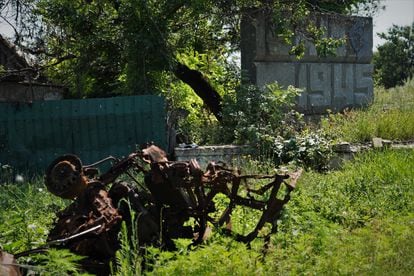 A monument in memory of World War II, in the town of Neskuchne, liberated in June from Russian occupation. The town’s residents still haven’t returned.
A monument in memory of World War II, in the town of Neskuchne, liberated in June from Russian occupation. The town’s residents still haven’t returned.
/cloudfront-eu-central-1.images.arcpublishing.com/prisa/SEHEV3AUIJABHPT4F5QI63NCQU.JPG)
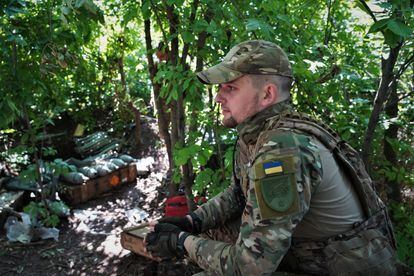
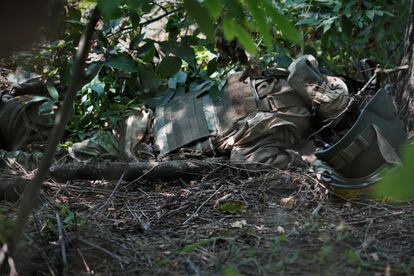
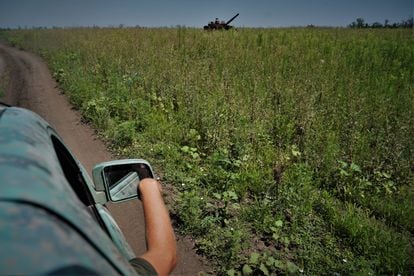
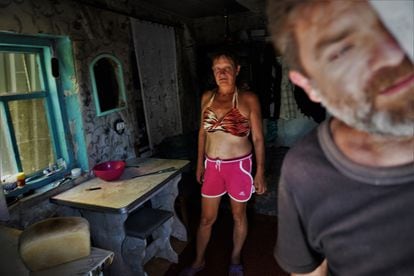
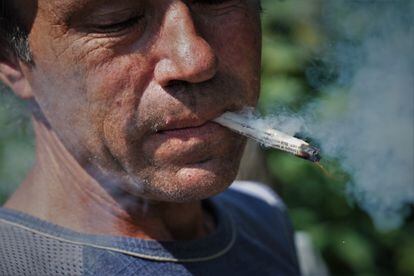

No comments:
Post a Comment